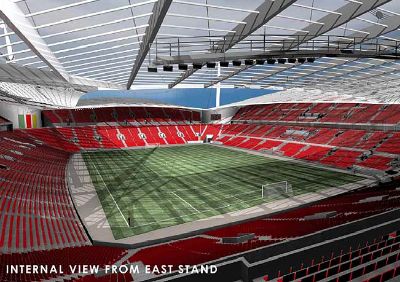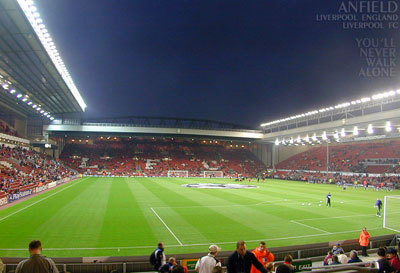Use our rumours form to send us football transfer rumours.
Enter Our Weekly Correct Score Competition
Anfield Stadium
Full Name: Anfield Stadium
Year Ground Opened: 1884
Capacity: 45,362
Home of: Liverpool FC
Pitch Size: 110 x 75 yards
Postal Address:
Anfield Stadium
Anfield Road
Liverpool
L4 0TH
United Kingdom
Tel: 0151-263-2361
Fax: 0151-260-8813
Record Attendance 61,905 v Wolverhampton Wanderers - FA Cup 4th Round, February 2nd, 1952
History Of Anfield Stadium
The greenfield site now known as Anfield was owned by John Houlding. Houlding was a brewer and local council member, who allowed Everton FC in 1884, to rent the land to play their matches. They previously rented a little field in Priory Road, north of Stanley Park, but were unwelcome because of the noisy crowds on match days. The first game played on the ground was between Everton and Earlstown on 28 September with Everton triumphing 5-0. Everton continued to use the ground until 1892 when the Everton Board disputed with Houlding over the amount of rent. Everton FC then moved across Stanley Park to the newly-built Goodison Park, less than a mile away.
During those eight years, Houlding had been a real motivating force behind Everton, and had erected a small stand for some of the 8,000 spectators that regularly attended the matches. After Everton FC left Houlding decided to form a new football team called Liverpool. One of the men who stayed loyal to Houlding was an irishman called John McKenna. McKenna had links to Scottish football and used his contacts to form a 13 man team, 9 of which were Scottish.
Liverpool's first game at Anfield was a friendly played on 1st September, 1892 against Rotherham. Liverpool won 7-1.
Liverpool's initial application to join the Football League was rejected and so they began life in the Lancashire League which they won easily in their first season
Liverpool were then admitted to the Football League, and won the second division championship without losing a game. Liverpool won the first division championship in 1900-01.
As crowds began to increase at Anfield, the club built a new stand in 1895 capable of seating 3,000 people. It was built on the site of the current Main Stand and remained until 1973, although changes were made to it over the years. In 1903 another stand was built at the Anfield Road end. It was built from timber and corrugated iron. In 1906 Liverpool won the League Championship for a second time and the directors decided to have a new banking built at the Walton Breck Road. Ernest Edwards who worked for the Liverpool Daily Post and Echo christened it the Spion Kop, after a hill in Natal, South Africa where a local regiment had suffered many losses during the Second Boer War
Other football grounds, such as St Andrews, Birmingham and Hillsborough, Sheffield, adopted the name of 'Kop' for one of their stands, but it was the Anfield Kop that became most synonymous with the name.
The anfield stadium remained much the same until 1928 when a major redevelopment occurred. The Kop was redesigned and extended to accommodate 28,000 people and a roof was constructed over the kop. It was then the largest Kop in the country.
The top mast of an iron ship, was hauled up the Everton Valley by horses and erected alongside the new Kop where it stood for many years.
In 1957 floodlights were installed. In 1963, the old Kemlyn Road stand was replaced by a cantilevered stand, seating 6,700 and cost of £350,000 to build. A couple of years later alterations were made at the Anfield Road end, turning it into a large covered standing area.
The largest redevelopment came in 1973 when the old Main Stand was taken down and replaced with an 12,277 capacity all-seater. It was opened by the Duke of Kent in March of 1973
The Kemlyn Road stand was renamed the Centenary stand in 1992 when a second tier was added to it for the club's centenary. An entire terraced street had to be demolished to make way for the Centenary Stand expansion. It cost £10 million and held 11,762 seats. The new stand also held executive boxes, dinning boxes and bars.

1994 saw the last ever game in front of the Kop stand. Norwich City were the visitors as 44,339 fans packed in to Anfield. The date of April 30th 1994 will go down in Liverpool history - but not for the result. Norwich won 1-0 courtesy of a Jeremy Goss strike at the Kop End.
Local folklore claimed that the fans in the Kop could suck the ball into the goal if Liverpool were playing towards that end. The kop was reduced in size due to safety measures brought in following the 1989 Hillsborough disaster, and it was completely rebuilt as an all-seater stand in May 1994 with a capacity of 12,249.
The Anfield Road Stand was rebuilt in 1998, with a capacity of 9,074, including the away fans section.
The ground incorporates several notable features, including a memorial to the 96 fans who died in the Hillsborough disaster. Alongside it are the names of all those who died. There is a also statue of Bill Shankly, as well as a pair of gates at two entrances to the stadium, the Shankly Gates and Paisley Gates, named after Shankly and his successor Bob Paisley.
Anfield has hosted six internationals, the first in 1889 when England beat Ireland 6-1. England have also played Wales there on three ocasions, in 1905, 1922 and 1931, winning all three matches. In 1926 Ireland drew with England. During the Second World War England and Wales managed a 2-2 draw in front of 38,000 at Anfield. Another international hosted was the World Cup game between Wales and Scotland in October 1977 when 50,000 saw Scotland triumph 2-0 to gain a place in the finals.

'Fortress Anfield' gained a reputation as one of the most difficult grounds for visiting teams. Manager Bill Shankly, had a sign proclaiming 'This Is Anfield' mounted on the wall above the exit from the players tunnel to intimidate the opposition. Many Liverpool players reach up and touch the sign as they pass underneath it for good luck.
Because of the difficulties expanding Anfield beyond its current boundaries, Liverpool will most likely leave the ground in the next few years, and have submitted plans for a new stadium within Stanley Park. If successful, the existing location will be redeveloped for the local community. The new stadium was suggested to be shared with Everton, but this is looks unlikely.